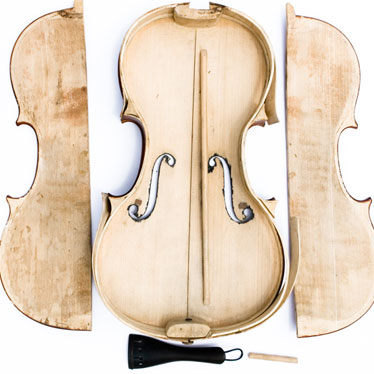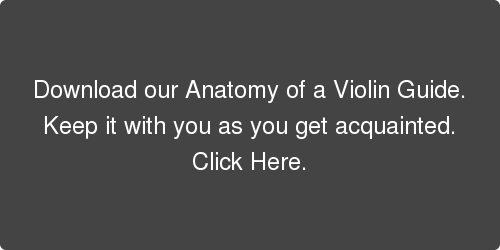Learning the Different Parts of Your Violin

Aside from the incredible music it creates, your violin is a detailed piece of artwork in its own right. Violins are crafted with artisan techniques that have been honed for over 400 years to produce the rich, warm tones that characterize it. However, to truly comprehend this versatile string instrument and keep it in top condition, it’s important to understand each part, and know how those parts interact to create its distinctive and beloved sound.
When you begin training, it’s a huge benefit to know your violin anatomy. Each component is important to the overall projection and timbre of your instrument, and like any great artist or professional, knowing how your tools function will help enhance your performance.
Violin Anatomy 101
Almost every part of violin anatomy is constructed of some type of specific tonewood, designed to resonate (vibrate) well. Spruce wood is almost always utilized for the soundpost and top plate (table or belly), but Maple, Rosewood, Ebony, and others are also employed on the remaining structural elements. Here’s a breakdown of the individual parts:
- Scroll: Starting from the top down, the scroll of your violin doesn’t contribute much to the sound, but it does often indicate the quality of the instrument; the more intricate the carving and deeply set eye (the center), the better.
- Peg Box: This hollowed out portion contains the tuning pegs and provides the attachment area for the strings.
- Tuning pegs: These tapered wood pegs hold your strings in place and tighten/loosen the string to achieve the proper pitch.
- Nut: This flat piece of wood connects the peg box to the fingerboard, but also determines the violin’s “action”. Essentially, it regulates how high your strings are from the fingerboard, and thus, how much pressure is required to play additional notes; but, it also separates the strings, directing them into the peg box properly.
- Neck: The neck on your violin anatomy forms the crucial connection between the body and the peg box, but it also supports the upper portion of the fingerboard. Located directly behind it, the bottom part of the neck is called the “saddle,” and it connects to the interior top block.
- Body: Your violin is constructed of a top, back, and sides. The table (or belly) is the convex-like plate that forms the top of your violin. The sides are called ribs, and are supported by blocks in the corners, top, and bottom inside. The ribs connect the top and bottom plates together at the sides and neck.
- Fingerboard: This piece constitutes the range of notes the violin can play. By pressing your fingers on the strings, making contact with the fingerboard, you shorten the string length to generate specific notes.
- Strings: As you know, the strings on your violin create the sound. Their particular anatomy is designed to produce a vibration when touched, which resonates throughout your entire instrument.
- Bridge: The bridge’s central location on the belly greatly effects the sound of your instrument. Basically, it’s the primary way that the vibration transfers from the strings to the body, bass bar, and soundpost. It features grooved notches for the strings, and flat feet. The location of the feet has an immense impact on sound production because they are situated directly above the bass bar and soundpost. All of your violin’s resonance ability depends on the bridge, and its placement.
- F-Holes: Those scripted openings on either side of the bridge are the sound holes, and these are where the waves of air generated inside your violin by the vibrations emerge as the sound.
- Tailpiece: This piece of violin anatomy attaches and separates the strings at the bottom of your instrument, and it holds the fine tuners (if applicable) for all four strings, or only the E-string.
- Tail Gut: Also called the tailpiece hanger, this small piece of wire or nylon connects the tailpiece to the end button. The end button holds it all place.
- Chin Rest: This piece is typically made from wood, and helps players maintain the correct playing position.
The interior view of your violin anatomy also includes some other, very important parts that you should be aware of, including:
- Bass Bar: This thin, wood strip runs almost parallel to the strings, under the G-string side of your bridge and is attached underneath the table.
- Soundpost: The sound post is a solid Spruce tube that “stands” directly under the treble end of the bridge and transfers the vibrations from the top plate to the back, and back again. It’s position is extremely important, but because it is not attached, it can shift inside the body. If that happened, have a qualified luthier re-set it.
Choosing to play the violin is an awesome decision, and by knowing your violin anatomy, you’ll be able to keep your instrument in great condition.


